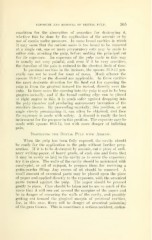Page 707 - My FlipBook
P. 707
EXPOSURE AND REMOVAL OF DENTAL I'L'LP. 365 ;
condition for the absor])tion of remedies for destroying it,
whether this be done by the apijlieation of the arsenic or by
use of cocain under pressure. In some broad cavities in which
it may seem that the carious mass is too broad to be removed
at a single cut, one or more preparatory cuts may be made to
either side, avoiding the pulp, before making the principal cut
for its exposure. An exposure of the pulp made in this way
is usually not very painful, and, even if it be very sensitive,
the duration of the pain is reduced to the shortest limit of time.
In proximal cavities in the incisors, the spoons 20-9-12 gen-
erally can not be used for want of room. Much oftener the
spoons 15-8-12 or the discoid are applicable. In these cavities
the most desirable direction for the final cut for exposing the
pulp is from the gingival toward the incisal, directly over the
pulp. In these cases the opening into the pulp is apt to be long
gingivo-incisally, and if the broad cutting edge can be placed
at right angles to this, it is much safer against dropping into
the pulp chamber and producing unnecessary laceration of the
sensitive tissues. By proceeding carefully, this position, or an
angle closely proximating it, can often be obtained, and then
the exposure is made with safety. A discoid is really the best
instrument for the purpose in this ]iosition. The exposure may be
made with spoons 10-6-12, but with more danger of inflicting
pain.
Destroying the Dent.al Pulp with Arsenic.
"Wlien the pulp has been fully exposed, the cavity should
be ready for the application to the pulp without further prep-
aration. If it is to be destroyed by arsenic, cut a piece of ordi-
nary writing-paper, of heavj^ grade, of such size and form that
it may be easily so laid in the cavity as to cover the exposure
try it in place. The walls of the cavity should be moistened with
eucalyptol, or oil of cajuput, to prepare them for receiving a
gutta-percha tilling. Any excess of oil should be removed. A
small amount of arsenical paste may be placed upon the piece
of paper and applied directly to the exposure, with the arsenical
paste turned against the pulp. The paper should be pressed
gently to place. Care should be taken not to use so much of the
paste that it will run out around the margins of the pajier and
be in danger of smearing the walls of the cavity, and possibly
getting out toward the gingival margin of proximal cavities,
for, in this case, thei'e will be danger of arsenical poisoning
of the gum tissues. This is sometimes a serious accident, endan-


